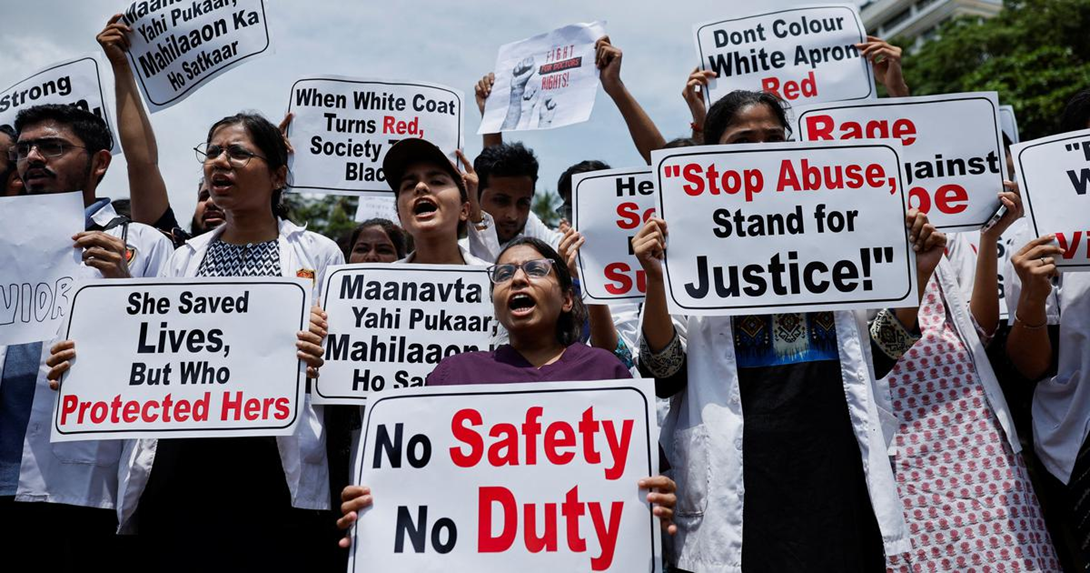- Courses
- GS Full Course 1 Year
- GS Full Course 2 Year
- GS Full Course 3 Year
- GS Full Course Till Selection
- Online Program
- GS Recorded Course
- NCERT (Recorded 500+ Hours)
- Polity Recorded Course
- Geography Recorded Course
- Economy Recorded Course
- AMAC Recorded Course
- Modern India, Post Independence & World History
- Environment Recoded Course
- Governance Recoded Course
- Science & Tech. Recoded Course
- International Relations and Internal Security Recorded Course
- Disaster Management Module Course
- Ethics Recoded Course
- Essay Recoded Course
- Current Affairs Recoded Course
- CSAT
- 5 LAYERED ARJUNA Mentorship
- Public Administration Optional
- ABOUT US
- OUR TOPPERS
- TEST SERIES
- FREE STUDY MATERIAL
- VIDEOS
- CONTACT US
When the law fails women
When the law fails women

The recent tragic case of a young doctor being raped and murdered in Kolkata has brought the issue of women's safety in India into sharp focus. This horrific event highlights persistent gaps in India’s legal and protective systems designed to safeguard women.
- Despite having numerous laws and increasing societal awareness, violence against women remains alarmingly high, reflecting deep-rooted systemic and cultural issues.
Statistics on Women's Safety
National Crime Records Bureau (NCRB) Data:
- Overall Statistics (2022):
- Total Crimes Against Women: 4,45,256 cases, a 4% increase from the previous year. This equates to approximately 51 FIRs every hour.
- Crime Rate: 66.4 per lakh population.
- Charge Sheet Filing Rate: 75.8%.
- Types of Crimes:
- Cruelty by Husband/Relatives: 31.4% of total cases.
- Kidnapping and Abduction: 19.2%.
- Assault with Intent to Outrage Modesty: 18.7%.
- Rape: 7.1% of cases.
- Historical Data:
- Sexual Violence Peaks: Nearly 39,000 incidents in 2016.
- Rape Frequency (2018): On average, one rape occurred every 15 minutes.
- Workplace Harassment: Over 400 cases reported annually since 2018.
- Juvenile Involvement: 86 cases of rape and 68 cases of outraging modesty of women.
- State-wise Data (2022):
- Delhi: Highest crime rate at 144.4 per lakh population, with 14,247 cases.
- Uttar Pradesh: Highest number of cases with 65,743 FIRs.
- Other States: Maharashtra, Rajasthan, and West Bengal follow with significant case numbers.
Challenges in Addressing Crime Against Women
- Patriarchal Societal Norms:
- Cultural Practices: Traditional norms often condone or perpetuate violence. For example, Khap Panchayats enforce rigid gender norms and sanction practices that undermine women's autonomy.
- Community Attitudes: Social acceptance of gender discrimination perpetuates violence and reduces women's agency.
- Workplace Exploitation:
- Legal Gaps: The Sexual Harassment of Women at Workplace Act (2013) aims to protect women but struggles with implementation, particularly in unorganized sectors.
- Industry-specific Issues: Reports, such as those from the Malayalam film industry, highlight pervasive sexual exploitation and inadequate internal complaint mechanisms.
- Unsafe Public Spaces:
- Infrastructure Deficiencies: Poorly lit streets and inadequate public transportation increase the risk of harassment and assault.
- Case in Point: The 2012 Delhi gang rape incident occurred in an area lacking adequate street lighting and safety measures.
- Insufficient Infrastructure and Resources:
- Lack of Facilities: Many areas lack functional police stations, forensic labs, and emergency services, hampering effective crime management.
- Resource Allocation: Inadequate allocation of resources to critical infrastructure impacts crime investigation and response.
- Weak Law Enforcement and Judicial Systems:
- Inefficiencies: Delays in trials and leniency towards perpetrators, as seen in the Nirbhaya case, expose systemic weaknesses.
- Conviction Rates: NCRB data indicates a low conviction rate for rape cases, fluctuating between 27% to 28% from 2018-2022.
- Systemic Corruption:
- Impact on Justice: Corruption can lead to mishandling or dismissal of cases, as evidenced by delays and procedural issues in cases like the Badlapur sexual assault.
- Bribery and Misconduct: Corruption within police and legal systems undermines the effectiveness of law enforcement.
- Social Stigma and Victim Blaming:
- Cultural Attitudes: Victim-blaming and stigma deter women from reporting crimes. Misguided societal attitudes often place undue blame on survivors.
- Political Insensitivity: Politicians sometimes make irresponsible remarks about rape cases, exacerbating victim-blaming.
- Gender Inequality and Cultural Attitudes:
- Educational Disparities: Inequalities in education and employment opportunities contribute to women's vulnerability.
- Cultural Practices: Practices like child marriage and dowry system perpetuate violence and inequality.
- Lack of Education and Awareness:
- Rights Awareness: Limited knowledge about legal rights and protections leaves women vulnerable and unprotected.
- Traditional Beliefs: In some regions, traditional beliefs and limited access to education prevent women from seeking justice.
- Economic Dependency:
- Financial Dependence: Women who are economically dependent on male family members may struggle to leave abusive situations.
- Economic Vulnerability: Financial dependence often traps women in abusive relationships due to lack of alternatives.
- Domestic Violence:
- Link to Severe Crimes: Domestic abuse often escalates to severe forms of violence, including sexual assault and murder.
- Underreporting: Domestic violence is frequently underreported due to stigma and fear of further abuse.
- Technological and Cyber Threats:
- Online Harassment: Rising incidents of cyberbullying, stalking, and non-consensual sharing of intimate images require updated legal and technical responses.
- Substance Abuse:
- Link to Violence: Perpetrators under the influence of alcohol or drugs often commit violence, exacerbating the issue.
- False Allegations:
- Impact on Victims: False allegations can undermine the credibility of genuine victims and discourage reporting, affecting overall trust in the legal system.
Frameworks and Initiatives
Legal Framework:
- Sexual Harassment of Women at Workplace (Prevention, Prohibition and Redressal) Act, 2013: Mandates Internal Complaints Committees, defines sexual harassment, and outlines procedures for complaint handling and investigation.
- Criminal Law (Amendment) Acts (2013 & 2018): Strengthens penalties for sexual offenses, introduces the death penalty for repeat offenders, and mandates expedited investigations and trials.
- Protection of Children from Sexual Offences Act (POCSO), 2012: Provides comprehensive measures for protecting children from sexual offenses and offers support systems for victims.
- Prohibition of Child Marriage Act, 2006: Establishes the legal age of marriage to prevent child marriages and protect young girls.
- Protection of Women from Domestic Violence Act, 2005: Defines domestic violence comprehensively and provides civil remedies for protection and relief.
Judicial Interventions:
- Joseph Shine vs. Union of India (2018): Decriminalized adultery, addressing control over women’s sexuality.
- Independent Thought vs. Union of India (2017): Criminalized marital rape for minors, closing legal loopholes.
- Laxmi vs. Union of India (2014): Directed regulation of acid sales and improved support for acid attack survivors.
- Delhi Gang Rape Case (2012): Led to major legal reforms, including harsher penalties and faster trial processes.
Government Initiatives:
- Nirbhaya Fund: Supports projects enhancing women’s safety, managed by the Ministry of Women and Child Development.
- One Stop Centres & Women Helplines: Provide integrated support and 24-hour emergency assistance to women affected by violence.
- Mahila Police Volunteers: Volunteers assist in bridging the gap between police and communities, supporting women in distress.
- Swadhar Greh Scheme: Offers institutional support, including shelter, food, healthcare, and economic security to women in challenging situations.
- Safe City Projects: Create secure environments for women and girls in public spaces, funded under the Nirbhaya Fund.
- Investigation Tracking System for Sexual Offences: Monitors and tracks time-bound investigations in sexual assault cases.
Recent Instructions for Healthcare Professionals:
In response to the Kolkata incident, the Union Ministry of Health and Family Welfare has mandated enhanced security in healthcare facilities. Key recommendations include:
- High-Resolution CCTV Cameras: Installation across key areas to monitor and deter potential threats.
- Control Rooms for Emergency Response: To ensure quick and effective handling of emergencies.
- Secure Duty Rooms and Transport: Enhanced safety measures for female healthcare professionals.
- Training for Security Personnel: Ensuring guards are well-trained in handling emergencies and maintaining security.
- Coordination with Local Authorities: Improved collaboration with local police and emergency services for a swift response.
Conclusion
The persistent issue of crimes against women in India requires a multifaceted and sustained approach. While existing frameworks and initiatives provide a foundation, effective implementation, and continual adaptation to emerging challenges are crucial. Strengthening laws, enhancing support systems, and addressing cultural and systemic issues are essential for creating a safer and more equitable environment for women.
By working collectively towards these goals, India can move closer to achieving genuine gender equality and justice, ensuring that women’s safety and rights are upheld at every level of society.
Must Check: Best IAS Coaching In Delhi
UPSC Prelims Result 2024 Out: Expected Cut Off & Other Details, UPSC Prelims 2024 Answer with Explanation, Daily Prelims Quiz, Daily Current Affairs, MONTHLY CURRENT AFFAIRS TOTAL (CAT) MAGAZINE, Best IAS Coaching Institute in Karol Bagh, Best IAS Coaching Institute in Delhi, Daily Mains Question Answer Practice, ENSURE IAS UPSC Toppers, UPSC Toppers Marksheet, Previous Year Interview Questions, UPSC Syllabus




